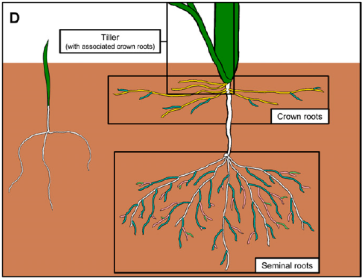Water. Nature’s currency.
With climate change becoming more obvious everyday, drought is something that farmers are becoming more accustomed to. Climate change figures project that water availability will become more erratic in the near future, with high rainfall over a short period of time, followed by no or low rainfall over a longer period of time.
As a result crops need to be able to function better without adequate rainfall. Fortunately, adaptation is something most plants do well. Scientists from José Dinneny’s lab at the Carnegie Institution for Science have hit upon a strategy some grasses utilise during drought stress. Grasses produce crown roots, which are roots originating from basal nodes (nodes at the base of the shoots). Crown roots are the major channel for water uptake, and they develop relatively early on in the plant’s growth. Plants use crown roots to sense the availability of water in the surrounding soil and subsequently stimulate further crown root growth. Dinneny’s team discovered that it is possible to induce changes in the root architecture, specifically the crown roots, when under drought stress. By subjecting the model grass Setaria viridis to water stress, crown root growth was suppressed. Root growth was analysed using the GLO-Roots luminescence imaging.

Diagram representing a wheat root system with crown roots.
To simulate drought conditions, water stress was induced, with no further watering after germination. This resulted in plants accelerating through their growth development stages – early onset of flowering, increased leaf formation and tiller formation (shoots other than the main shoot of the plant). It also caused a dramatic decrease in crown root growth, with plants maintaining a more limited root system under water-deficient conditions. Dinneny’s team concluded that S. viridis did this as an austerity measure – slowing down their water uptake ultimately means less energy is utilised and so more of the water can be conserved in the plant shoots and not lost through transpiration.

GLO-Roots luminescence imaging – The roots on the left (A) show changes in crown root growth 11 days after germination under well-watered (WW) and water-deficient (WD) conditions, while the roots on the right (B) were not imaged until 17 days after germination. Both sets of roots show suppressed crown root growth after a period of drought.
Interestingly enough, the fate of the roots can be reversed. When water-deficient plants were re-watered from the base of the pot after a period of dry, the plant could resume a more healthy root growth. In comparison, when the plants were re-watered from the top of the pot, the crown roots revive and development was reactivated. This suggests that the crown of the plant has the ability to sense local water availability in order to induce or pause crown root growth.

These series of images show the reactivation of crown root growth over time after water-deficient plants were re-watered (G).
So what does this all mean for agriculture?
Suppression of crown root growth was also shown to occur under drought conditions in other members of the Poaceae (grass) family. Sorghum, switchgrass and Brachypodium distachyon also showed strong suppression of crown root growth. In wildtype maize there was a near-complete suppression. Using this knowledge, it could change how plant breeders tackle the issue of variable water supply. Crops could be breed to have better responses to water deficiency, by enhancing the response of the crown roots. With further development of crop management strategies and new breeding techniques, improvement of the environmental and economic sustainability of food production can become a firm reality.
With climate change and the unreliability of rainfall, we don’t just need plants, we need clever plants.
#rootsforthewin
Link to journal paper:
Sebastian J., Yee M.-C., Goudinho Viana W., Rellán-Álvarez R., Feldman M., Priest H. D., Trontin C., Lee T., Jiang H., Baxter I., Mockler T. C., Hochholdinger F., Brutnell T. P. and Dinneny J. R. (2016) Grasses suppress shoot-borne roots to conserve water during drought. Proceedings of the National Academy of Sciences 113, 8861-8866.
http://www.pnas.org/content/113/31/8861.full


One thought on “Getting to the root of the situation”